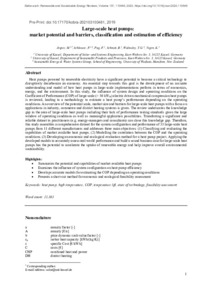| dc.date.accessioned | 2021-03-11T10:06:34Z | |
| dc.date.available | 2021-03-11T10:06:34Z | |
| dc.date.issued | 2019-12-20 | |
| dc.identifier | doi:10.17170/kobra-202103103481 | |
| dc.identifier.uri | http://hdl.handle.net/123456789/12614 | |
| dc.description | Siehe auch: Renewable and Sustainable Energy Reviews, Volume 137, 110646, 2020, https://doi.org/10.1016/j.rser.2020.110646 | ger |
| dc.description.sponsorship | This work was supported by the German Federal Ministry for Economic Affairs and Energy within the framework of the 6th Energy Research Program [project: “SolarAutomotive”, grant number 0325863A]. | ger |
| dc.language.iso | eng | eng |
| dc.rights | Namensnennung 4.0 International | * |
| dc.rights | Namensnennung - Weitergabe unter gleichen Bedingungen 4.0 International | * |
| dc.rights.uri | http://creativecommons.org/licenses/by-sa/4.0/ | * |
| dc.subject | heat pump | eng |
| dc.subject | high temperature | eng |
| dc.subject | COP | eng |
| dc.subject | temperature lift | eng |
| dc.subject | state of technology | eng |
| dc.subject | feasibility assessment | eng |
| dc.subject.ddc | 333 | |
| dc.subject.ddc | 620 | |
| dc.title | Large-scale heat pumps: market potential and barriers, classification and estimation of efficiency | eng |
| dc.type | Preprint | |
| dcterms.abstract | Heat pumps powered by renewable electricity have a significant potential to become a critical technology to disruptively decarbonize an economy. An essential step towards this goal is the development of an accurate understanding and model of how heat pumps in large-scale implementations perform in terms of economics, energy, and the environment. In this study, the influence of system design and operating conditions on the Coefficient of Performance (COP) of large-scale (> 50 kWth) electric driven mechanical compression heat pumps is reviewed, leading to a methodology to estimate a heat pump’s performance depending on the operating conditions. An overview of the potential scale, market size and barriers for large-scale heat pumps with a focus on applications in industry, commerce and district heating systems is given. The review underscores the knowledge gap in the area of large-scale heat pumps including their lack of performance testing standards given the large window of operating conditions as well as meaningful application possibilities. Transferring a significant and reliable dataset to practitioners (e.g. energy-managers and consultants) can close this knowledge gap. Therefore, this study assembles a comprehensive dataset for the system configuration and performance of 33 large-scale heat pumps from 11 different manufacturers and addresses three main objectives: (1) Classifying and evaluating the capabilities of market available heat pumps. (2) Modelling the correlation between the COP and the operating conditions. (3) Developing an economic and ecological evaluation method for a heat pump project. Applying the developed models to accurately assess real-world performance and build a sound business case for large-scale heat pumps has the potential to accelerate the uptake of renewable energy and help improve overall environmental sustainability. | eng |
| dcterms.accessRights | open access | |
| dcterms.creator | Jesper, Mateo | |
| dcterms.creator | Schlosser, Florian | |
| dcterms.creator | Pag, Felix | |
| dcterms.creator | Schmitt, Bastian | |
| dcterms.creator | Walmsley, Timothy Gordon | |
| dcterms.creator | Vajen, Klaus | |
| dc.contributor.corporatename | Kassel, Universität Kassel, Fachbereich Maschinenbau, Fachgebiet Solar- und Anlagentechnik | ger |
| dc.relation.doi | doi:10.1016/j.rser.2020.110646 | |
| dc.relation.projectid | 0325863A | |
| dc.subject.swd | Wärmepumpe | ger |
| dc.subject.swd | Hochtemperatur | ger |
| dc.subject.swd | Stand der Technik | ger |
| dc.subject.swd | Wirtschaftlichkeit | ger |
| dc.subject.swd | Energieeffizienz | ger |
| dc.subject.swd | Großanlagenbau | ger |
| dc.type.version | submittedVersion | |
| kup.iskup | false | |


